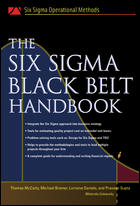As I write this, it is day 10—day 10 of a government shutdown in the United States. It is impossible to turn on the television, surf the Internet or open a newspaper without being bombarded with the latest accusations, roadblocks and seamingly endless parade of stories of frustration and alienation. If someone were to do research on the most uttered phrases of the last 10 days, terms like “refuse to compromise,” “Armageddon” and “this is their fault” would most likely top the list.
It’s enough to make me resign myself to listening to sports talk-radio. But that’s not exactly a cure for avoiding the blame game. Instead, I began to wonder how our politicians might benefit from the knowledge, experience and processes of the quality industry.
For instance, what could our government officials learn from one of the most popular management philosophies in our industry—Six Sigma.
In the weeks leading up to this crisis, many of the talking heads on television speculated that threat of a shutdown would be a tactic to demand a curbing of government spending, in essence, to save the government, and its people, money. According to Praveen Gupta, director of corporate quality at Prysm, the reason Six Sigma is so popular is, “that there’s no other methodology that has received credit for saving so much money. Companies have reported savings in the billions of dollars. No other methodology comes close to Six Sigma for savings.”
Additionally, as the shutdown continued, news coverage began describing instances of individuals, families and institutions being hurt by the shutdown—veterans not receiving benefits and children unable to receive medical treatment. Politicians began suggesting legislation to address these issues as they came up. It was called “piecemeal” legislation. This gave rise to the inevitable question. As all of these situations came to light, which was to be corrected? Which program or service that was not being funded during the shutdown was to be funded or reopened? Which one of the proverbial squeaky wheels was to get the oil? The scenario above suggests, at the least, that this piecemeal process is ill-defined.
With Six Sigma, the methodology is separated into steps referred to as DMAIC, or Define, Measure, Analyze, Improve and Control. The first step is Define. And, as Praveen says, “a problem well-defined is half-solved.”
You can check out the full Q&A with Praveen in this month’s Quality. And remember, November marks the beginning of World Quality Month. This month’s column by ASQ “celebrates the valuable contributions quality workers make for their companies, their communities, and the world,” and shares the vision of World Quality Month, which, in part, is, “to employ quality principles to reduce headline-making errors and calls on people who use quality tools to share their knowledge…to illustrate the value of quality principles.”
It’s a vision our politicians should aspire to.
Enjoy and thanks for reading!



